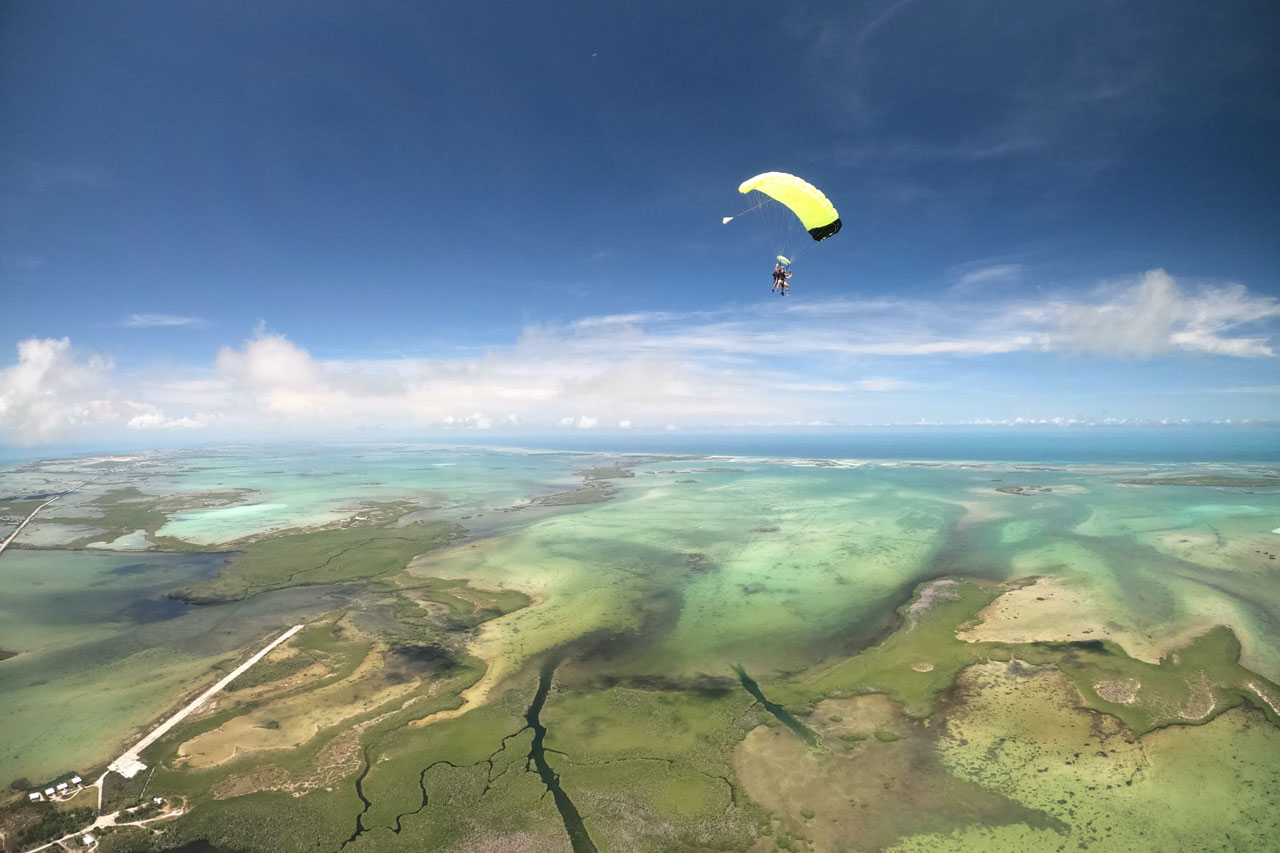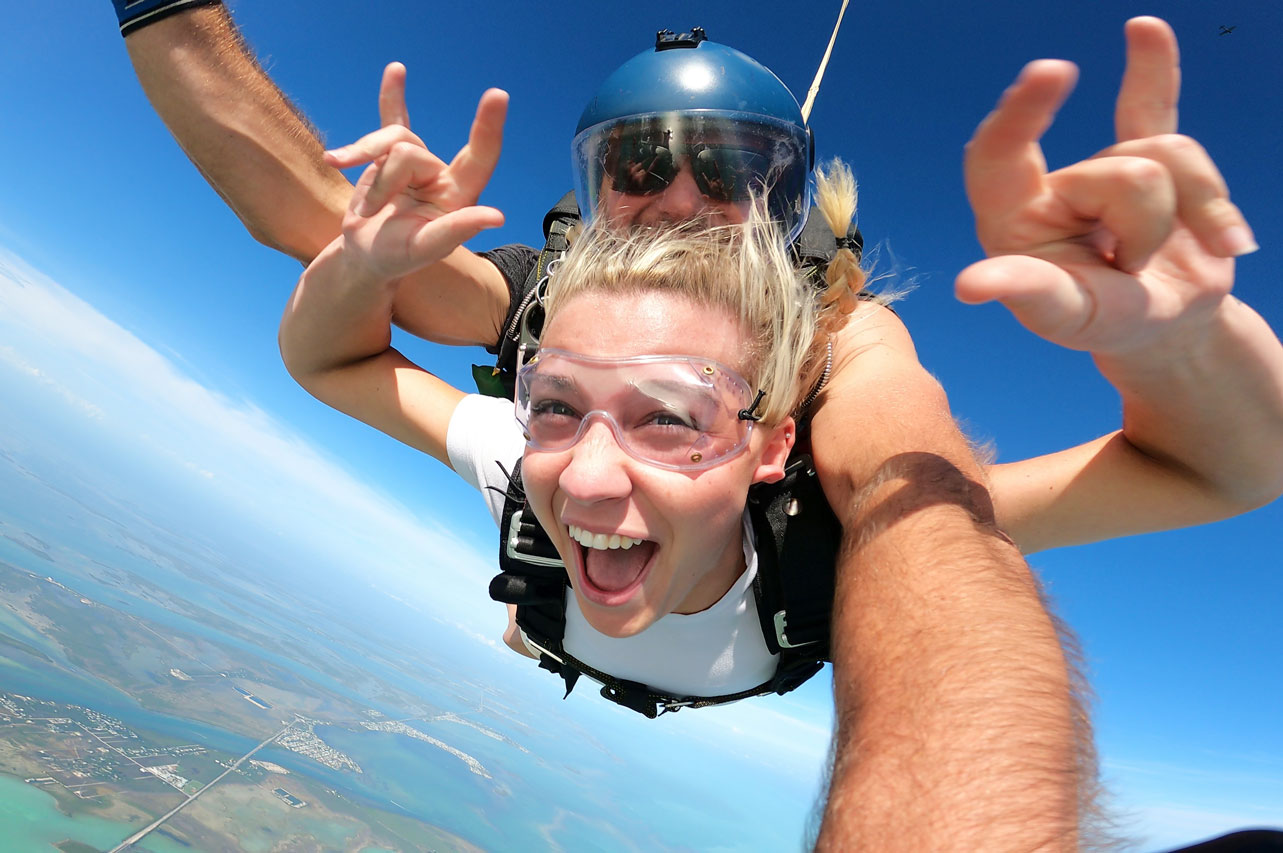How Does the Parachute Work?
Skydiving
Posted by: Skydive Key West
2 years ago
Skydiving parachutes are far more than beautiful bundles of fabric and stitches: rather, they are constantly evolving engineering marvels that enable the sport of skydiving to persist.
Parachutes are designed with functionality in mind. For example, parachutes used for military ventures, delivering heavy cargo or supplies, will differ in their construction and design than a parachute used by a licensed skydiver for fun. Likewise, within the sport skydiving industry, parachutes are specifically designed with different purposes and types of skydives in mind. For instance, the features of a skydiving parachute used by a wingsuiter will be a bit different from those of a skydiving parachute manufactured for tandem skydiving.
Though technical design specifications will vary amongst parachutes based on desired flight characteristics and performance, there are fundamental features that enable all parachutes to work.
Curious to learn more? Keep reading for the inside scoop on how a skydiving parachute works plus a sneak peek at what to expect when it’s time for the parachute ride on your very first skydive.

How Does A Parachute Work: Parachute Physics
At the most fundamental level, skydiving parachutes work by utilizing one fascinating aerodynamic feat: air resistance.
Here’s a quick physics refresher. If you dropped a feather and a stone in a vacuum with no air, you’d find that they both strike the ground at the same time. This is because both objects have an acceleration of 9.8 m/s². Now, if you were to conduct this experiment yourself in the “non-vacuum real world,” you’d find that the stone most certainly reaches the ground first. And why is that?
Air resistance!
You see, though invisible, the air is composed of a nearly unfathomable number of gas molecules. As an object falls, it encounters these molecules producing resistance. In the case of the feather and stone, the feather has a larger surface area which, in turn, allows it to come into contact with a larger number of air particles as it falls thus creating greater aerodynamic drag / air resistance.
Parachute physics are practically the same. A skydiving parachute utilizes the principle of air resistance. By increasing aerodynamic drag, parachutes reduce the rate of descent of an object or person. Furthermore modern parachutes are constructed from lightweight nylon material which has been chemically treated to be less porous – meaning less air permeates the fabric. This type of fabric further increases parachute air resistance.
How Does A Parachute Work: Parachute Flight
A modern skydiving parachute does more than allow the user to gently descend. Instead, they are actually maneuverable “wings.” So, what enables a parachute to fly?
Parachutes consist of several separate, sealed chambers we call “cells.” The front of each of these cells is open. As the parachute moves forward, air fills the cells – giving the parachute its semi-rigid structure and forming an air-foil. Skydivers are able to steer the parachute wing by pulling down on steering lines which slightly alter the shape of the parachute causing it to turn.
What Does It Feel Like When A Parachute Is Pulled?
Many people worry that the opening of the parachute will hurt. Thankfully, skydiving parachutes have been designed so that the force of opening is done in a controlled and staged manner that reduces the amount of snatch force felt by the body.

Staged Parachute Deployment
We refer to the time when the parachute is pulled as the parachute deployment. Parachutes are designed so that a staged deployment sequence occurs. The sequence is initiated by a “mini” parachute we call the pilot chute.
When it is time to deploy the parachute, the pilot chute is extracted from a pouch on the bottom of the skydiving container. The pilot chute inflates and creates enough drag to then extract the main parachute from the skydiving container. Parachutes are packed with the opening of the cells we mentioned above facing forward. Additionally, a pivotal piece of fabric called the slider is quartered and tucked within the parachute.
When the main parachute is extracted by the pilot chute, it emerges from the deployment bag. The slider slides down the lines of the parachute. Because of air resistance it descends in a slow measured manner and slows the parachute inflation so that each of the cells of the parachute fill with air in an efficient but gentle manner. Ahhhhh.
Tandem Skydiving Parachute Deployment
On a tandem skydiving parachute, instead of a pilot chute there is a drogue parachute. The drogue parachute serves a similar function to the pilot chute, but because the drogue must extract a parachute designed to carry two passengers rather than one, it is significantly bigger than the pilot chute used on sport skydiving rigs.
Another difference is that the drogue parachute is deployed shortly after the tandem pair exits the aircraft. It is used to slow the rate of descent of the tandem pair to a speed that is safe for parachute deployment.
Similar to the process described above, when the tandem skydiving instructor pulls the handle to release the main parachute, the drag created by the drogue pulls out the main parachute and allows it to inflate. Again, the trusty slider moderates the opening speed of the parachute and reduces the amount of force felt by the tandem student and instructor.
See How A Parachute Works In Person!
Why leave how a parachute works to the theoretical realm? Why not take the leap and find out first-hand what skydiving feels like? Jump into paradise with Skydive Key West today! Blue skies!




